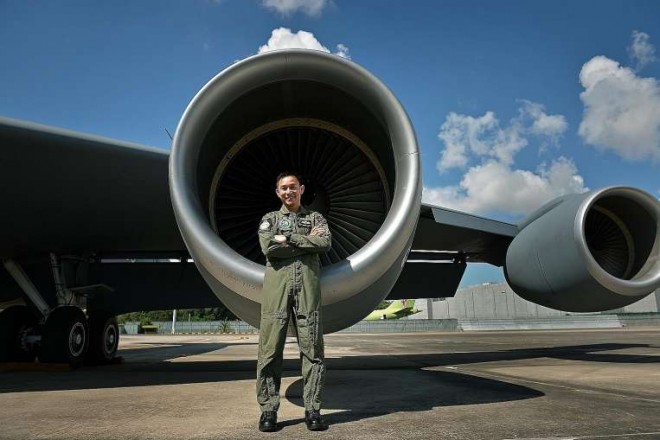
At age 12, Zakir Hamid was in the spotlight as a compere on the popular Malay children’s show Aksi Mat Yoyo. At age 23, he made the news when he became the Republic of Singapore Air Force’s (RSAF) first Malay pilot in 1992.
Now the boyish-looking 46-year-old is in the limelight again for becoming the highest-ranked Malay officer in the RSAF, after he was promoted from Senior Lieutenant-Colonel to Colonel in June. As commander of the RSAF’s Transport Group, he has 400 to 500 servicemen under him.
But Col. Zakir demurred when asked about what this achievement means for the Malay community. Instead, he told The Straits Times: “Frankly, I don’t think of myself as different. I think of myself as a member of the team.
“I don’t see myself exclusively as a member of the minority. I like to see myself as a role model for other young Singaporeans who aspire to be pilots,” said Col Zakir, whose wife is 46 and an entrepreneur. They have a daughter, nine.
Col. Zakir admitted, though, that he did feel some pressure when he became the first Malay pilot.
“But I try not to let that affect me. My principle is the same – that if I’m going to do something, I do it in the best way that I can,” he said.
Col. Zakir’s love for aviation goes back to his childhood days of playing with toy planes. He and older brother Farid would build balsa wood gliders that could fly with a plastic propeller and a rubber band.
“We would tether them to a line, stand in the center, and the plane went in circles around you. It could go only up and down and do loops. When it comes to aerodynamics, I had, at a young age, understood how an aircraft flies,” he said.
Col. Zakir, who also has two older sisters, was active in school. “I did a lot of things in school… from the Interact Club to track team to shooting to rugby to soccer to hockey… In Primary 1, I had double the number of ECA (extra-curricular activities) points required,” he said.
By 18, he had been to faraway places such as Chile on a three-month charity expedition for youth.
During his national service, he won the coveted sword-of-honor at Officer Cadet School; he graduated top of his class at James Madison University in Virginia where he studied geographic information systems and mass communications on a military scholarship.
In 1990, the then Guards officer got a chance to become an RSAF pilot, with hopes of becoming a fighter pilot. However, when he was in flight school in 1991, he was found to have a medical condition called sinus barotrauma, dashing his aspirations of becoming a fighter pilot.
“What happens is that your sinus cavities get weak and they get blocked,” he said. He could still fly – but only transport planes.
“You don’t have to go through changes in pressure as dynamically as you do in a fighter… In transport (planes), you don’t zoom from zero to hero in a matter of seconds.”
But he said it was a blessing in disguise, as flying transport planes has given him more opportunities to be involved in overseas missions as well as humanitarian and disaster assistance relief operations.
Col. Zakir went on three tours in the Gulf in 2005, 2007 and 2008, of six weeks to a month. He flew the KC-135 tanker aircraft, which he calls the “petrol kiosk in the sky”. Their missions involve providing air-to-air refueling for coalition jets in Iraq and Afghanistan.
“The temperatures in summer can soar up to 50 degrees (Celsius), with sandstorms and strong wind conditions. And, in winter, it can be very cold at night,” he said.
Col. Zakir, who has held positions such as commanding officer of the 122 Squadron, which operates the KC-135, now oversees a fleet comprising the C-130 transport aircraft, the G-550 Airborne Early Warning aircraft, the Fokker 50 and the KC-135. He ensures that the crew members are ready for operations.
He still remembers his first taste of being a pilot: he was 18 and steering a friend’s glider plane up in the air in Britain.
“I enjoyed that experience, and really felt how it was like to be a bird, (and) to be able to maneuver the aircraft, the silence of being one with your environment.”
RELATED STORY
Fitness buff has his career all worked out